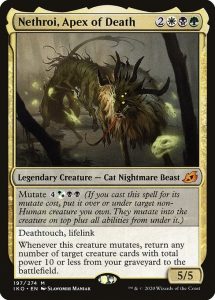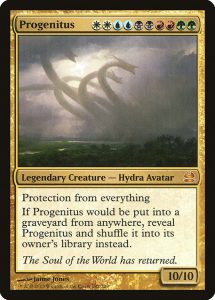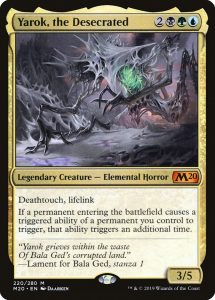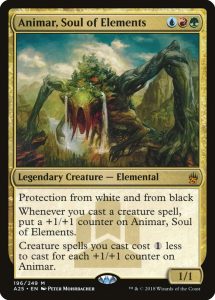Table of Contents
- What is Mutate and How Does it Work?
- Mutate Frequently Asked Questions
- Here’s Why You Should Use It
- The Downside of Mutate
- Wrap Up
Have you ever looked at two Magic: the Gathering cards and thought to yourself that one would be way better if it only had the abilities of the other? If you answered yes to that question, then you’d probably love Mutate, a mechanic introduced in the Ikoria: Lair of Behemoths set.
Mutate, as the name implies, allows you to essentially “fuse” two creature cards together while keeping all their abilities. This leads to some absolutely crazy combinations…but it also leads to some questions.
In this post, we’ll be discussing how mutate works in MTG. We’ll go over some of the more frequently asked questions, as well as the benefits and drawbacks of using this mechanic.
What is Mutate and How Does it Work?

Ikoria: Lair of Behemoths was a set all about grisly, bizarre, and fantastic fusions of different creatures. A great example of one of these weird fusions would be Porcuparrot, whose art depicts a combination of a porcupine and a parrot.
Given the artistic theme of the set, it’s not surprising that a mechanic like Mutate was developed. Just like the odd combo-creatures on the cards, Mutate basically allows you to take creatures and fuse them together.
Any card with the Mutate keyword on it has an alternate cost by the word. When you choose to use Mutate, you pay the alternate cost to cast it as a mutate creature, which then gets attached on top of or beneath a non-human creature that you own.
Whichever card is on top is the resulting creature. It gets all abilities from the creatures attached underneath it. Essentially, you can form mutant creature stacks represented by the one on top with additional abilities from the ones below.
These “Mutant stacks” can be as long as you like. No matter how many Mutate creatures are attached to the top creature, though, the whole pile of them still counts as one single creature.
In some ways, it’s a little like attaching equipment to a creature. However, the difference is that the resulting mutant creature can only be represented by the Mutating creature card, or the targeted creature.
In other words, you don’t get to add power and toughness levels from all creatures, nor does your mutant get to have all the names of the creatures it fused with. It is simply one creature with the abilities of the others.
Mutate FAQs
Can Mutate be Countered?
When you pay the Mutate cost, you cast a mutating creature spell. Like most other spells, it can still be countered.
Also like most other spells, a mutating creature spell that has been successfully countered simply goes to your graveyard. Nothing new or complicated here.
Interestingly, if the creature you’re targeting with your mutating creature spell is removed from the battlefield, the mutating creature spell still resolves. Instead of being attached to the other, though, it resolves and enters the battlefield as a creature of its own.
How Does Mutate Work with Summoning Sickness?
If you’re new to the game, summoning sickness occurs on the same turn a creature is cast. When the creature enters the battlefield, it needs a moment to adjust, so it usually can’t attack on the same turn. (There are, of course, exceptions, such as if the creature has haste. One thing that can safely be said about MTG is that there are almost always exceptions.)
Summoning sickness is not applicable to mutating creatures. You are not summoning a new creature, but instead applying the mutation to one that is already on the battlefield. Provided the target of the mutation has been out for at least one turn or has haste, you will still be able to attack with it once the mutation has occurred.
What Happens When a Mutated Creature Dies?
Remember, a mutated creature is still just one creature. No matter how many mutating creature spells are applied to it, you do not get to count it as multiple – each component adds up to a whole.
Thus, when the mutated creature dies, the whole thing dies, including all the creatures below it. All of them go to the graveyard at the same time.
How does flicker work with Mutate?
Flickering is when someone causes a creature to go into exile, then return to the battlefield immediately after. It’s commonly done as a defensive measure to protect a creature from harm.
Unfortunately, your mutated creature won’t come out of exile in one piece. When you flicker it, it breaks down into all its individual components once it returns to the battlefield.
What happens if you bounce a mutated creature?
Bouncing is when a permanent is returned to the owner’s hand. Some people choose to bounce their own creatures so they can protect them from harm, and others choose to bounce opponents’ creatures to temporarily remove them as threats. Bouncing is also often done to re-trigger enter the battlefield effects.
When you bounce a mutated creature, because it is counted as one creature, all return to your hand at once. They split during this process into individual creatures once more. If you’d like them to be mutated together again, you will need to cast them all over.
Does mutate count as casting?
Yes, mutate counts as casting. You are still paying a cost for the card.
Can you mutate into Progenitus?

Progenitus, pictured above, is a beefy creature that was originally printed in the Conflux set. As you can see, he’s pretty darn impressive with a massive 10/10 power and toughness. Furthermore, any time he would go into your graveyard, he goes back into your library again, meaning you can keep bringing him back repeatedly.
But perhaps his most interesting ability is his protection from everything. In a nutshell, Progenitus cannot be targeted by anything, he can’t be dealt damage by anything (including combat), and he can’t be blocked by anything. You can read more about that particular ability in this informative post about protection from everything.
You can see why someone would want to Mutate Progenitus. He’s already scary as hell, so why not make him more so, right?
Unfortunately, as awesome as that would be, you cannot mutate into Progenitus. His protection from everything quality prevents him from being targeted by mutating creature spells.
Does Mutate enter the battlefield?

“Enter the battlefield” (ETB) refers to when a card is moved from another zone onto the battlefield. Typically, this occurs when it is cast.
This is important, because there are many cards, such as Yarok, the Desecrated, which have abilities triggered by cards entering the battlefield. As an example, consider the aforementioned Yarok, whose picture is above.
A mutating creature spell will not trigger cards like Yarok with ETB abilities. That’s because they do not enter the battlefield, and instead simply fuse with another creature that is already on the battlefield.
Here’s Why You Should Use It

So is Mutate worth using, or is it something you should avoid?
Mutate is definitely worth trying out! There are a few reasons for it being so good.
For one thing, it’s like an improved version of aura/enchantment spells. If the target of your mutating creature is no longer legal (due to be being destroyed or removed from the battlefield in some way), the mutating creature spell still resolves, albeit as an independent creature. This is unlike enchantments, which instantly go to the graveyard if their target is no longer legal.
Second, the Mutate cost is generally cheaper than casting the creature itself. It’s basically getting the creature’s abilities for a discount.
Third, the only real restriction on mutating is that it can’t be applied to a human creature, which means it works with essentially every set ever released because they all have non-human creatures in them. This means that there are infinite possibilities for the combos you can come up with in eternal formats like Commander.
Fourth, Mutate is technically a casting cost. As such, effects that would reduce casting costs, like Animar, Soul of Elements’s ability, apply to the cost. That means you can make the already lower Mutate cost even lower.
The Downside of Mutate
The one biggest drawback to Mutate is that, regardless of how many creatures are under the mutated one, they still only count as a single unit. Applying a long list of mutating creature spells to one creature is like putting all your eggs in one basket.
If the one mutated creature is destroyed, so, too, are all the cards beneath it. In other words, all someone has to do is destroy that one creature and they’ve basically killed two (or more) birds with one stone. They’re likely only out one card, while you’re out however many cards you put on that creature.
Wrap Up
Mutate can seem really complicated when you look at the rules for it. However, if you think of it as being sort of like turning a creature into an equipment spell, it makes a little more sense.
Overall, this ability’s pros far outweigh its cons. As frequent Commander players, we have no doubt that is one ability that will see use in our own decks.
Want to learn more about Magic: the Gathering mechanics? If you have the time, try reading our article on how Adventure works.

So let’s say you cast a mutate creature for it’s mutate cost, then before it materializes, somebody destroys the creature it is mutating on?
What happens?
On MTG Arena that incoming card materializes.
Can’t find anything definitive so I believe what Arena does. Is there an actual answer though, as to why?
Hello,
Per the MTG Comprehensives rules (you can find them here, and I’m specifically referring to rule 702.140b), if the target of your mutating creature is no longer “legal” or has been removed by an opponent, the mutating creature card just resolves as a creature on its own. So it’s correct in MTG Arena for the incoming mutating creature to materialize after the destruction of its target. This would happen in a physical game, as well.
There’s also a helpful article on it here that addresses Ikoria mechanics in general.